Museday Mumblings (Vol. 36): Line 6
I have a confession to make.
I have been using fakery to get my sounds for over 20 years.
It’s true. Rather than relying on actual analog circuitry to create the sounds I use on stage, no matter whether I’m playing bass or guitar, generally-speaking and for the vast majority of the past 20 years, I’ve been using a technology called “modeling”.
If you happen to be unfamiliar with the technology, modeling defines a variety of techniques used to digitally emulate analog circuitry. They basically take a real amplifier or effects module and do a TON of measurements on it to see how it behaves and then they convert that information into computer algorithms that create a precise replica of how those analog circuits change the signals that pass through them.
I was first introduced to this technology through Line 6’s very first product, the AxSys 212 guitar amplifier. It frankly blew me away with all the different sounds you could get out of it. There really wasn’t anything on the market like it at the time. There were a few amps that sort of did the same thing, but none that did it as well or in quite the same way. It had this incredible footswitch that connected by just ONE Cat-5 cable that basically turned the amp into a multi-effects rack that was completely foot-controllable – no pedal board needed.
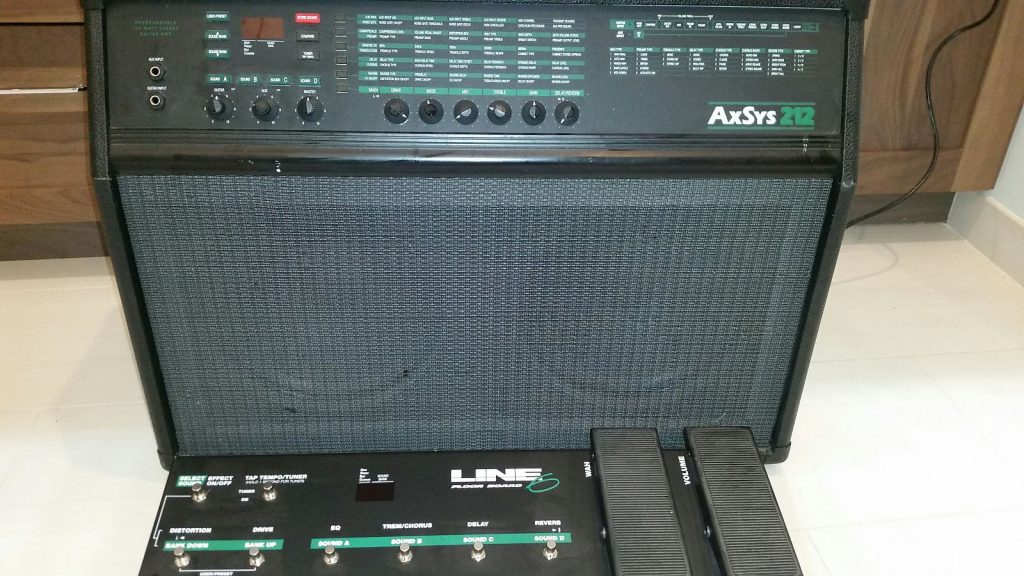
Line 6’s physical modeling “Tube Tone” technology was the first that really kind of breathed like a “real” amp to me. I didn’t have anywhere near enough money to afford it, nor did I want something that looked as weird as it did, but it definitely put the company on my radar.
A year or two later, I had gainful employment and was looking to get a new amplifier because I wanted to have something reliable and loud enough to gig. The leading candidate at the time was a Peavey Special 212, because I really liked the idea of not having to worry about tubes or my amp being particularly delicate. And I really liked the Peavey TransTube analog circuit – it was just mushy enough to make me not miss having tubes. So every time I’d go to my local music emporiums, I would plug into a Special 212 and play a little, and frequently I’d pop over to the Line 6 stuff to see if there was anything new, and that’s when I saw their “Flextone” line of amps. I thought, “Wow – this sounds just as good as that big boy. And you can use that big foot controller, too!” The price was still too steep for me at the time, but I did gather up a promo CD that previewed the sounds available in Flextone, and kept my eyes open while borrowing my brother’s Fender Ultimate Chorus when I needed enough volume to play over a drummer.

Here’s the audio from that promotional Flextone CD, in case you were curious:
I was thinking, “If only they’d create something that would allow me to afford this revolutionary technology…” Then they introduced POD.
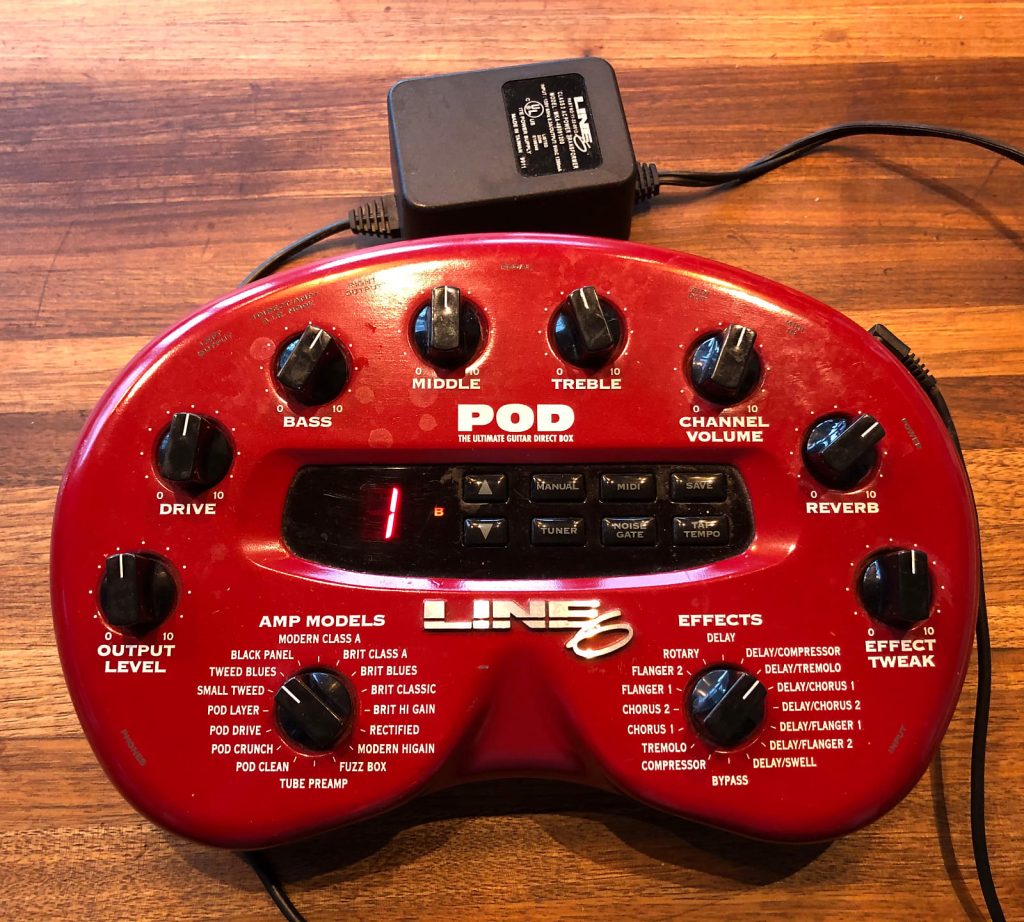
I HAD to have it.
It was a lot cheaper than their amps, AND it worked with that big Floor Board thing from the AxSys!
In early 1999, I did a payment plan with American Musical Supply and got the Line 6 POD, the Floor Board (which now didn’t have that green stripe on it – it was just black and white), and a nice little bag to hold the POD and power supply. Considering I’d just gotten myself a nice computer and my first “real” audio interface, this POD was the perfect next step to be able to really record my music. I didn’t figure I’d be playing gigs any time soon, as I’d just started playing bass with a cover band and I figured that’d occupy my time.
I realized from the start that I could also get a great sound plugging the POD into my PA system…the POD wasn’t designed just as an effects box to put into a guitar amp, and honestly, it didn’t sound particularly good when run like that, even with the “amp” setting on the outputs. So that became my guitar rig – POD into PA. Little did I know that kind of setup would basically be my guitar and bass rig for the rest of my career as a musician.
In June 2000, Line 6’s next excellent product (for me) hit stores: Bass POD.
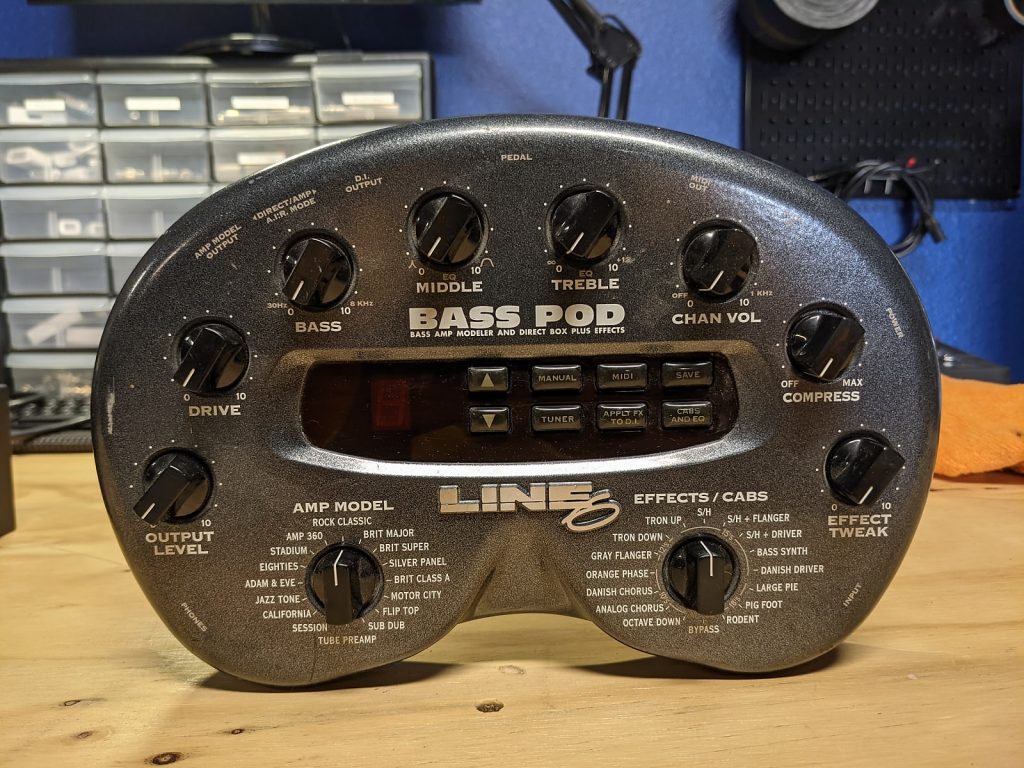
I bought one the first day it was out. I called George’s Music (at the time, probably the best music store in Jacksonville, way out at the beach, about an hour’s drive from my house in Orange Park) and they put one behind the counter for me. This changed my whole approach live.
Before, I’d just run into my combo amp and send the XLR direct out to the PA. And unfortunately, it had a buzz and didn’t translate my amp tone particularly well. Now, I’d run the amp model output to the PA we were using, however large or small, and I’d have a big-ass bass tone rumbling through the PA system. I’d run the DI out to my amp on stage for a little more localized thumping. I’d use the Floor Board with it to switch effects or boost my signal, or to run a wah-wah sound and cut my volume between sets or for bass changes. It was great. I loved the sound. I loved the weird looks on sound guys faces when they heard how awesome my bass sounded through their PA. I was fully hooked. Eventually, I’d ditch the amp and just get my bass sound from my on-stage monitors. Lugging the bass amp just wasn’t worth it.
Over the years, I’ve become quite a Line 6 fanboy, participating in various user forums (as Tripper), owning a ridiculous amount of different Line 6 products, and even making friends with people who work there (or worked there) online. Once I even was in a development group where I had to sign an NDA helping Line 6 with ideas for their next products. I was even kind of a part of Line 6’s marketing, since pictures of me were used to create line drawings in the marketing materials for one of the products. I never really wore the rose-colored glasses that most fanboys have – I’ve always acknowledged the superiority of analog circuits – but the gap between the analog originals and modeling technology has grown narrower with every new generation of modeling, from Line 6, Fractal Audio Systems, Kemper, or whoever.
As new POD units came out, I’d upgrade, as they always seemed to find more detail and get closer to a more “real” sound. I’ve owned at least one of every generation of POD. Lots of amps, too. I had one of the original Spider amps for a little while. It kind of sucked, to be honest. I sent it back and used the cash to get a Flextone II Plus that I purchased from an internet buddy who had created a head enclosure for the amp guts that I would later use with a Carvin stereo 4×12″ cabinet for a cool half-stack setup. I got lucky and picked up their flagship Vetta amplifier (with an even BIGGER floor board) for an amazing deal, and I lugged that heavy beast to all my 2003-2006 guitar-playing shows when there was room. When there wasn’t room, I’d just use a PODxt.
I was an early-ish adopter of their Variax guitars – the original black one I got (which at a little over $900 is still the most I’ve ever spent on a guitar) – is still my #1 choice for playing acoustic shows (since it has a great acoustic guitar emulation built in). The Variax system modeled different guitars, and using the specialized VDI connector with a piece of Line 6 gear that had the capability, you could save your guitar settings in the amp or floor unit with your amp settings and switch them immediately – going from a clean acoustic sound to a Les Paul into a crunchy Marshall amp with one stomp of your foot.
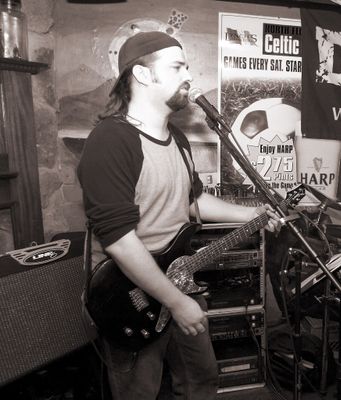
Around 2007 or so I eventually got a POD X3 Live, and it is one of my favorite pieces of gear I’ve ever owned. It has a VDI connector and the dual-amp feature of the Vetta, but in a compact and light floor board format with one pedal (I used for volume and wah) that fit perfectly on basically every stage but gave you full control over your settings.
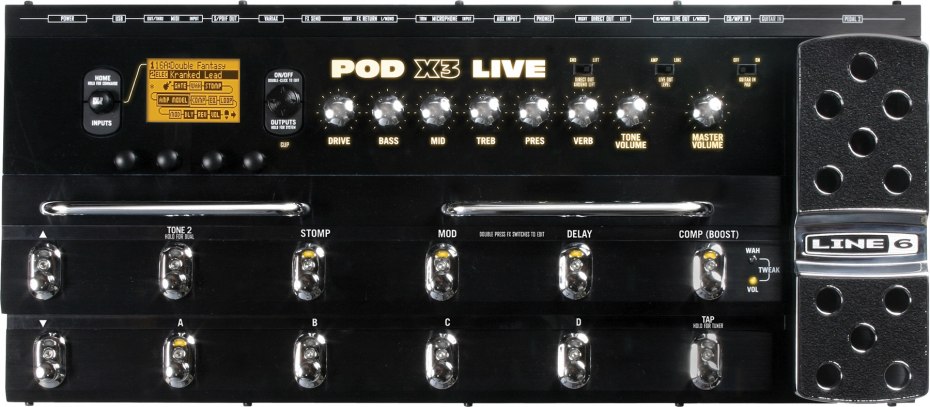
The X3 Live was my main rig for bass and guitar for years, and then I got the POD HD500, which had very little capability for bass. So the X3 remained my bass rig and I tried to make the HD500 work for guitar. I also acquired a James Tyler Variax JTV-69 that became my #1 for electric guitar shows. When I played guitar with the band Nudge in 2014 I used the JTV-69 with the HD500, and again for my brief tenure with Flext in 2016.

Photo by Cecily Johnson
Eventually they sold add-ons to expand the capabilities of the HD500, but I wasn’t that impressed overall and it fell into disuse once I took the leap of faith and bought the very-expensive-but-utterly-brilliant Helix in 2017 (like my original POD, on a payment plan from AMS).

After getting Helix, I didn’t really want anything else. Then they announced HX Stomp, which is basically a tiny Helix and the perfect little rig for me to use for my bass gigs. I had to have that, so I managed to trick Guitar Center into giving me a massive discount shortly after they appeared in stores, and it’s been my #1 bass rig ever since.

I owe so much of my creativity and fun with music over the past 22 years to Line 6, their wonderful community of users and their creative and useful products. Some musicians like to crap on them, and that’s fine. Not everyone is going to “get it”.
Line 6 started out small, grew massive with the success of the POD amp modeling/effects units and their Spider amps, lost their way for a while in the late 2000s/early 2010s and made some truly uninspired gear and questionable marketing choices, but have returned to form, most recently under new ownership as part of Yamaha Guitar Group. They have an inspired team of designers and developers constantly improving all the Helix/HX series and their other products, the community of users is better than ever, and their customer service (at least for North American customers) is second to none in their industry.
I’ve always been able to make their gear work for me and sound great in the process. One of my favorite things as a Line 6 user is having people come up to me at shows, especially snobby musicians, and compliment me on my sound, only to have them be utterly shocked when they see what I’m running.
Thanks, Line 6. I’ve given you lots of my money over the years, but it’s been worth every penny and more. I’m proud to be a Line 6 fanboy.
Peace be the journey!
TMS
APPENDIX: A list of the Line 6 things I’ve owned over the years (I still own all but the starred ones – I don’t think I forgot anything):
POD (the original – version 1.4 – never updated to 2.0)
POD bag (fits POD and power supply)
Floor Board
Floor Board bag (fits a POD and the Floor Board)
POD amp bracket (allows POD to be mounted to mic stand or on top of an amp on its handle)
Bass POD
Spider 112* (original red Spider) – took back to buy…
Flextone II Plus with…
Flextone Cab (turned Flextone II Plus into 100w stereo amp)
Flextone amp cover
PODxt (new generation modeling technology – added all extra amps and effects through “model packs” – lives with my brother now)
Vetta Combo* (2×12″ LOUD guitar amp that did two models at a time with…)
FBV Longboard* (an even BIGGER floor board with more switching ability)
FBV Longboard bag
Bass PODxt* (sold in 2019 – it had been used maybe twice in a decade)
Variax guitar (later renamed “500”)
Variax 300 guitar
Variax Bass 5-string
Pocket POD
POD X3 Live
Variax Bass 4-string* (sold because I don’t really play 4-string bass much)
Relay G30 Wireless (perfect for over 10 years – input jack just broke in 2020)
TonePort GX USB recording interface
GearBox VST (computer recording plugin)
TonePort DI USB recording interface
POD Farm VST (computer recording program/plugin)
James Tyler Variax JTV-69 guitar (my #1 gigging guitar other than acoustic)
POD HD500* (sold in 2020 because I wasn’t using it anymore)
Helix Floor (best bit of modeling gear I’ve ever owned)
Helix Backpack (got for free on a special when I bought Helix)
Helix Native (computer plugin version of the Helix)
TonePort UX8 8-channel USB interface (bought at a pawn shop cheap)
POD X3 (the bean-shaped one-got cheap to use at work and as a backup rig)
HX Stomp (like a teeny baby version of the Helix – my main bass rig)
POD Go (like a more simplified version of the Helix)
Powercab 112 Plus (just got Tuesday – a clever amplification solution)